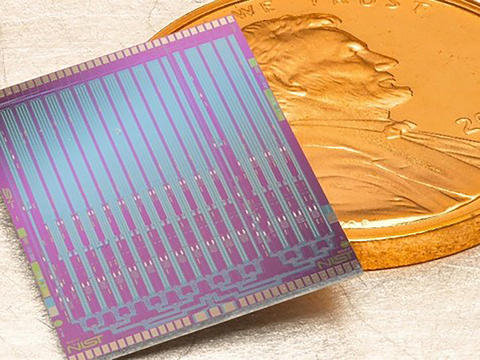Programmable Josephson Voltage Standards and Arbitrary Waveform Synthesizers

The Technology
NIST researchers are continuing to develop instruments that are already “gold standards” for generating output voltage with maximum accuracy within a certain range. Two of these devices are both well known and trusted by the research and development communities.
One is the Programmable Josephson Voltage Standard (PJVS), which generates user-specified DC voltages from -10 V to 10 V. The other is the Josephson Arbitrary Waveform Synthesizer (JAWS), which generates user-determined AC waves of various shapes (such as the square waves used in digital switching) at 2 V and frequencies of millions of cycles per second. Mature versions of NIST’s PJVS and JAWS systems are currently available through the Standard Reference Instrument program. Both are primary standards — that is, they do not need to be calibrated against any other standards because they are based on a fundamental, invariant quantum phenomenon.
In May 2019, as a result of the redefinition of SI units, Josephson standards became the authoritative means by which to realize the volt.
These technologies are now poised to progress to the next level at higher voltages and AC frequencies. Recent improvements in NIST’s PJVS have reduced measurement uncertainties in comparing DC output from two nonprogrammable Josephson Voltage Standard (JVS) instruments to less than one part in 10 billion, an achievement with worldwide impact on increased confidence in test results.
Advantages Over Existing Methods
Both the DC and AC voltage standards are produced in the Boulder Microfabrication Facility. The 10V PJVS chip is 12x17 mm, containing 32 arrays and 265,116 Josephson junctions, and the 2V JAWS chip is 10x15 mm, containing eight arrays and 102,480 Josephson junctions. Because the Josephson junctions consist of superconducting components, the devices must operate at low temperatures (4 kelvins, -270 C, -452.2 F). The equipment associated with low temperature operation plus necessary electronics means both systems are about the size of a washing machine. NIST scientists are working to miniaturize the devices, raise the operating temperature to more easily attainable levels, and find ways to reduce the instruments’ cost.
In addition, work is underway to automate many of the operations in the instruments and to ultimately make voltage standards more readily usable by customers at their own sites. NIST is intensely engaged in boosting output voltage and increasing the generated AC frequencies to billions of cycles per second.
Applications
Dozens of next-gen technologies will require testing, measurement and calibration standards with unprecedented levels of accuracy for DC and AC voltages.
Quantum-accurate waveforms and standardized test signals will be increasingly essential for evaluating equipment performance for manufacturers and operators in microwave industries, radar, defense and homeland security, wireless communications and the internet of things, including high-speed transfer of medical information from sensors on the patient to diagnostic systems.
Higher-frequency voltage signals will be especially useful for advanced communications. For example, the first generation of 5G communications devices will operate at frequencies up to 6 GHz, about three times higher than the upper limit for 4G phones.
Key Papers
A. Rufenacht, N. Flowers-Jacobs and S. Benz. Impact of the latest generation of Josephson voltage standards in ac and dc electric metrology. Metrologia. Aug. 24, 2018. DOI: 10.1088/1681-7575/aad41a
N.E. Flowers-Jacobs, A.E. Fox, P.D. Dresselhaus, R.E. Schwall and S.P. Benz,. Two-Volt Josephson Arbitrary Waveform Synthesizer Using Wilkinson Dividers. IEEE Transactions on Applied Superconductivity. Sept. 2016. DOI: 10.1109/TASC.2016.2532798
S.P. Benz et al. One-Volt Josephson Arbitrary Waveform Synthesizer. IEEE Transactions on Applied Superconductivity. Feb. 2015. DOI: 10.1109/TASC.2014.2357760
C.J. Burroughs et al. NIST 10 V Programmable Josephson Voltage Standard System. IEEE Transactions on Instrumentation and Measurement. July 2011. DOI: 10.1109/TIM.2010.2101191
C.A. Hamilton. Josephson voltage standards. Review of Scientific Instruments. Sept. 29, 2000. DOI: 10.1063/1.1289507
C.A. Hamilton, C.J. Burroughs and R.L. Kautz. Josephson D/A converter with fundamental accuracy. IEEE Transactions on Instrumentation and Measurement. April 1995. DOI: 10.1109/19.377816
Key Patents
J. Przybysz et al. Josephson junction digital to analog converter for accurate AC waveform synthesis. United States Patent US 5,812,078. Sept. 22, 1998.
S.P. Benz et al. AC and DC bipolar voltage source using quantized pulses. United States Patent US 6,236,344. May 22, 2001.
A. Rüfenacht, N.E. Flowers-Jacobs, A.E. Fox, P.D. Dresselhaus and S.P. Benz. Josephson Voltage Standard. United States Patent US 11,557,708. April 8, 2020.
S.P. Benz, J.A. Brevik, M.A. Castellanos Beltran, P.D. Dresselhaus, P.F. Hopkins and C.A. Donnelly. Superconducting Waveform Synthesizer. United States Patent US 10,797,684 B1. Oct. 6, 2020.
Contacts
-
(303) 497-5211

